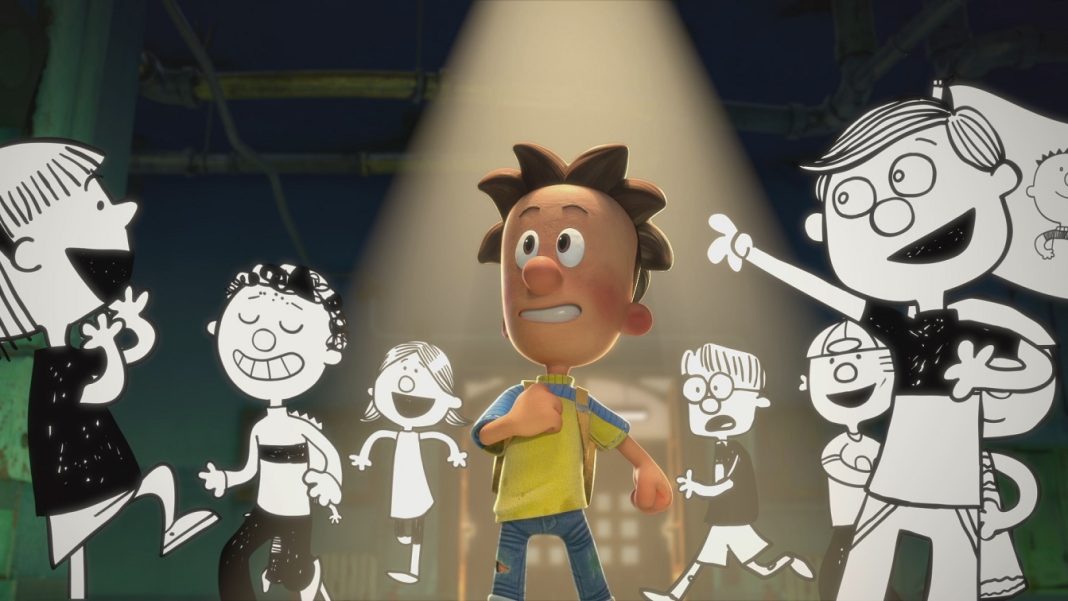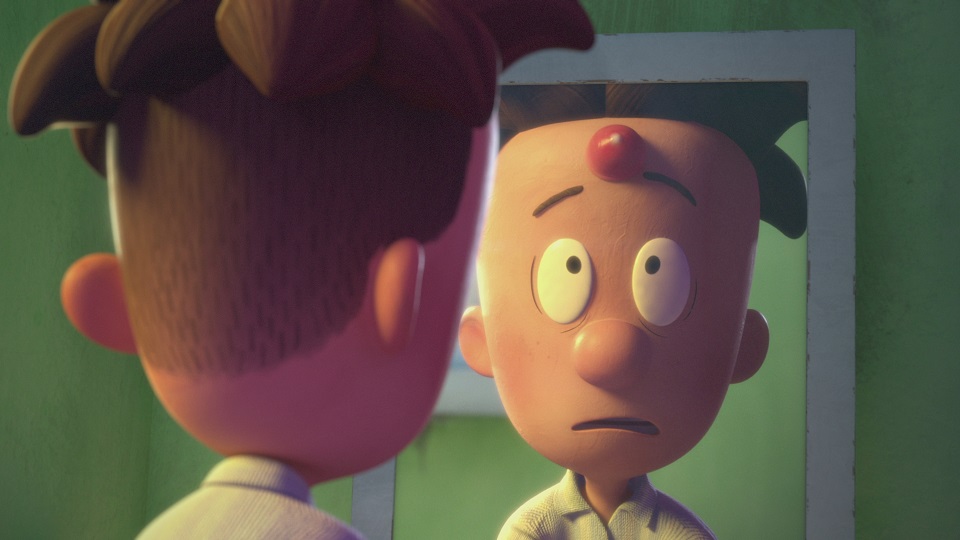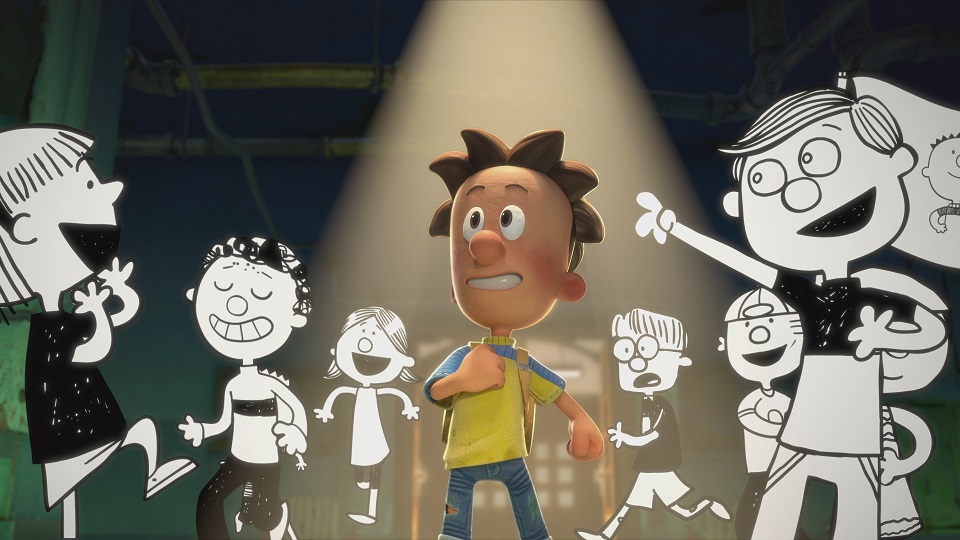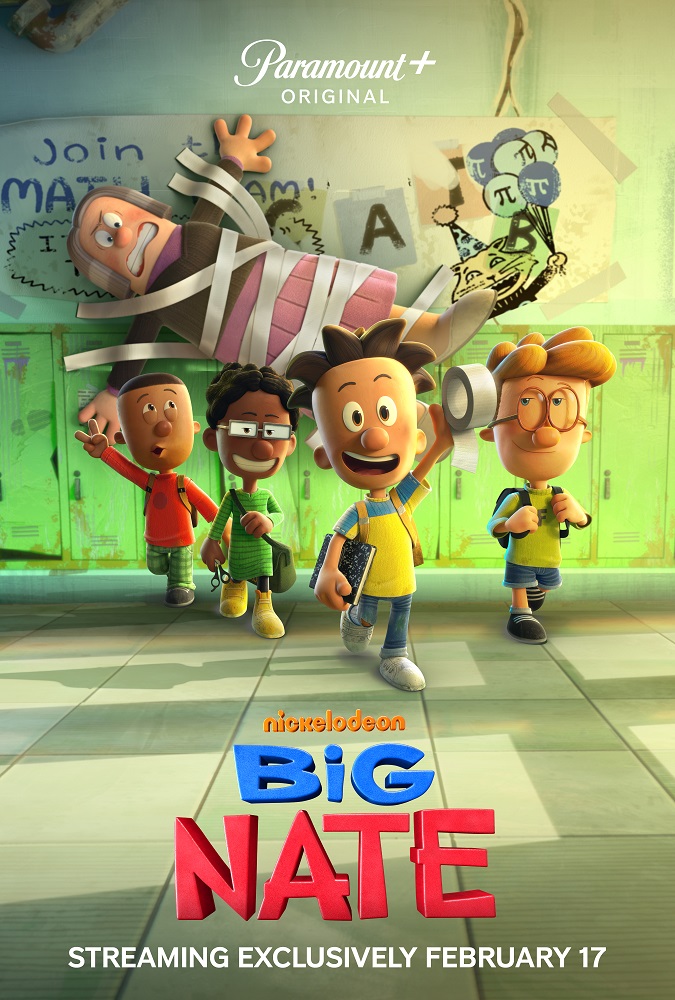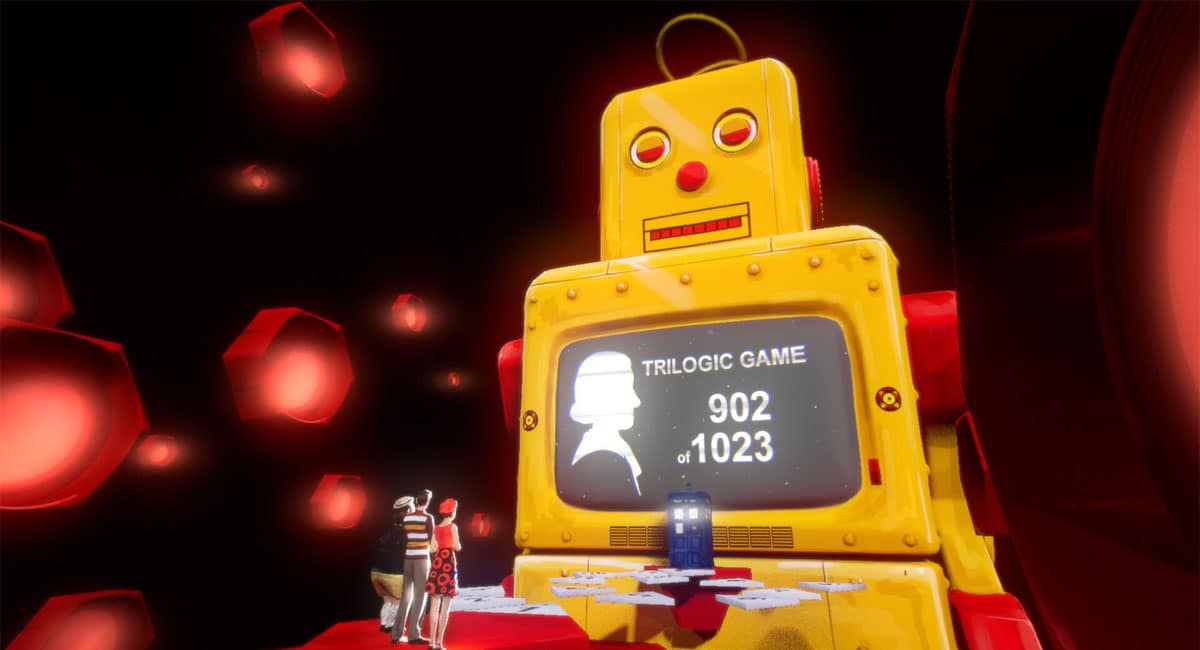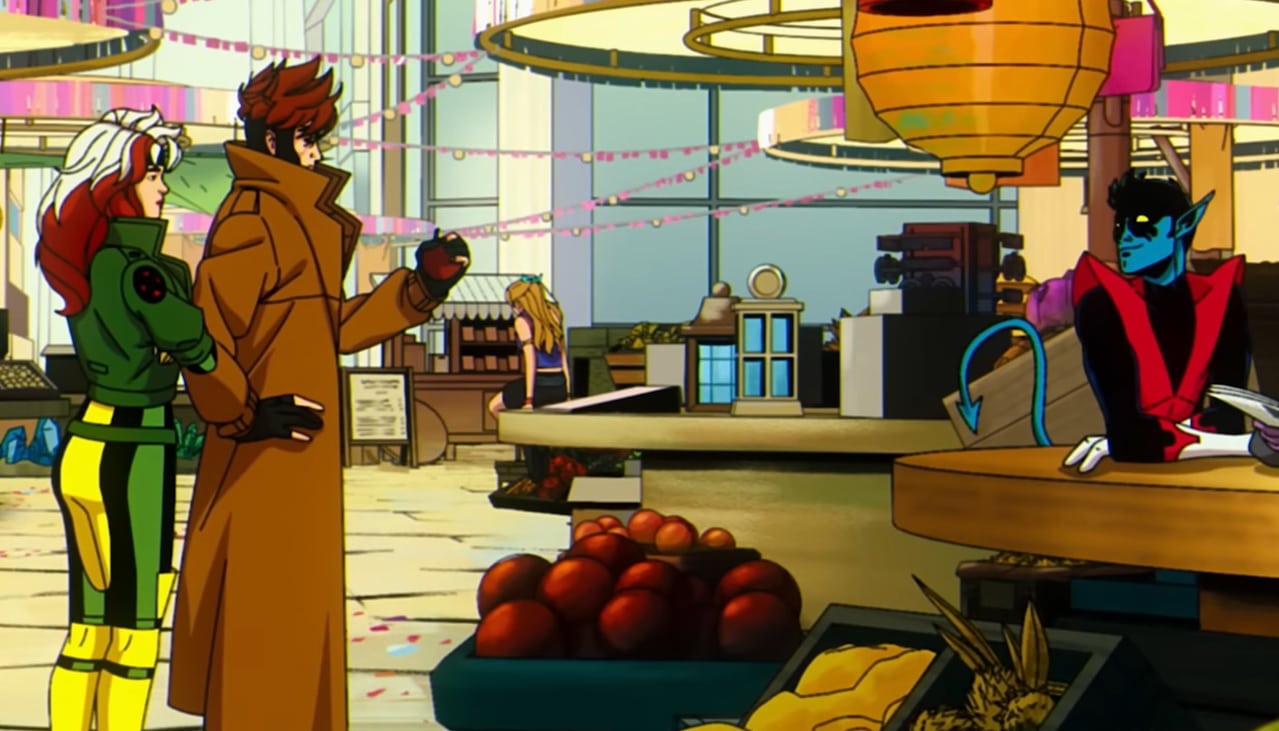The beloved comic strip Big Nate by cartoonist Lincoln Peirce has evolved quite a bit from a newspaper comic strip first debuted in 1991 to a full-blown media franchise that includes illustrated novels and even a stage musical. After more than three decades though, Big Nate is ready to hit the small screen with the new animated Big Nate series from Nickelodeon. The cartoon, like the original syndicated comic strip, follows the trials and tribulations of the titular Nate Wright, an underachieving yet bold and headstrong sixth grade student with dreams of greatness, and the coterie of colorful characters in his life.
The Beat had the chance to chat not only with Big Nate creator Peirce ahead of the animated show’s premiere, but also with the animated show’s executive producers John Cohen and Mitch Watson.

Lincoln Peirce: I’d say that soon after the book series began we started getting some offers for either movies or television. But none of those offers early on were for animated properties. They were for live-action projects. I just turned all those down out of hand because my philosophy was Big Nate is a comic strip. He’s a cartoon character. So if he’s going to be on a TV show or movie he should be animated. Eventually we made a handshake deal with a producer named John Cohen who had worked on the Despicable Me series and ended up producing the Angry Birds movies. He wrote me a letter about Big Nate and why he liked Big Nate and why he thought Big Nate would only work as an animated show. He checked off all my boxes and he sort of became our representative and went around trying to find us a partner to work with on a potential Big Nate show or movie.
It took awhile. He had a lot of meetings and knocked on a lot of doors and kept saying, “We’re going to get the right deal eventually.” And we did with Nickelodeon. I think that the reason it worked really well was because when John met with Nickelodeon and [President] Ramsey Naito, she had a child who knew Big Nate and was familiar with the property. One of the great things about Nickelodeon is that we’re making a show that is a faithful adaptation of the world of the Big Nate comic strips and the books and that was important to me. They’re also using the show as a platform to go off on tangents and tell the sorts of stories that are impossible to tell in a comic strip that is only 4 panels long. They are a great partner because of that and the people involved. We have Mitch Watson as our executive producer and head writer. He’s phenomenal. David Skelly as the art director is largely responsible for the look of the show, the attention to detail, and character designs. It took awhile but I’m delighted that when we made a deal we made it with Nickelodeon.
Taimur Dar: While most people know you for your comic work, you’re no stranger to animation. In fact, you actually worked on that “Super John Doe Junior” short for Nickelodeon. Did that prior relationship with Nickelodeon play a part?
Peirce: That was an interesting project to work on. It was part of a shorts program. As I recall, Nickelodeon had a partnership with an animation house called Frederator. Through that I got the chance to create this short about a little superhero who was frustrated because he was the son of a superhero but did not have his dad’s powers. From working on that project, I knew a couple of the names at Nickelodeon years later. I ended up hooking up with them and we circled back and reminisced. A lot changes in just a few short years. Just the very nature of TV animation has changed so much that when we were starting out and John Cohen was pitching Big Nate, I think he was pitching it as a 2D property. At some point down the line it became clear that if it’s going to be animated it’s going to be in 3D. That’s sort of the industry standard at this point. That was exciting too knowing that there was going to be this challenge to turn these 2D characters into 3D characters. It’s beyond any expectation I could have had.
Taimur Dar: The end credits feature original comic drawings by you. Aside from that, how involved are you in the day-to-day operations of the show?
Peirce: When they were first working on the initial character designs they asked me to take a look and create some draw turnarounds and to create a template for the way that Nate moves in 2D. And then they incorporated some of those drawings in their character designs when they were essentially creating the 3-Dimensional models. I’m more involved in the writing part. We have a great writers’ room and they create the outlines and the first drafts of the scripts and then I see the scripts. They call what I do “punching up the scripts.” I’ll add some jokes or rewrite some dialogue to make it sound more consistent with the way characters speak in the strip or the books. That’s been really fun for me because I’ve always worked by myself pretty much on my own. It’s fun to collaborate. I didn’t know if I would enjoy it or be any good at it. It’s fun to collaborate when the people you’re working with are so talented and excited about the project.
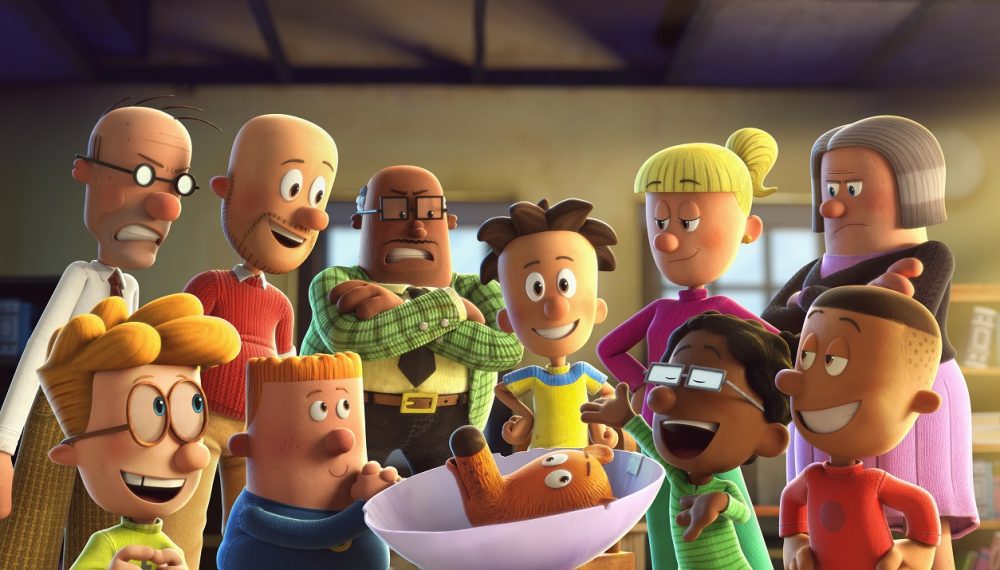
Peirce: It’s been really interesting to see how much more world-building you can do on TV and animation than you can do in the strip, just visually speaking. I can hint at the fact that the kids are in school by drawing a bank of lockers behind them or a couple of classroom desks but I really can’t expand beyond that. There’s not enough space. One of the things that we talked about early on in our production meetings was expanding the world of Nate’s school, P.S. 38, and amplifying a theme I wrote in one of the Big Nate novels which was that the school is old and falling apart. There’s a rival school too, literally across the street, called Jefferson Middle School. And that school is this palatial, sparkling, state of the art facility where students have every luxury and convenience. That’s very consistent with a theme in the strip but we’re able to amplify it on the show. There haven’t been any changes where I thought, “That would never happen.” Nickelodeon has been really careful to maintain the integrity of the characters and their personalities. Inevitably they won’t look exactly like they do in 2D because that’s impossible. But I think they are a phenomenal representation in 3-Dimensions. It’s been a great learning experience for me.
Taimur Dar: Gross-out humor has been part of Nickelodeon’s brand pretty much since its early days. It’s definitely showcased in the Big Nate cartoon, perhaps more than the comics, at least the ones that I read. How do you feel about the emphasis on gross humor in the show?
Peirce: I think that Nickelodeon really knows its audience and when you’re talking about who your audience is, it’s a very different animal from one to the other. I remember when I started the comic strip, one of the things that my first editor told me was that people don’t want to be grossed out over their morning coffee. And kids don’t really read newspapers. Even though Big Nate has become known over the years as a kids’ property and comic strip, I don’t really write the comic strip for kids. I write it for readers of all ages. It’s probably read by at least as many adults as it is kids. That’s very different from the novels that I wrote which were specifically for a kid audience or from the TV show which is targeted at a kid audience. In those cases, I think you can push the envelope a little bit more in terms of the gross-out humor. If you spend any time around an 8 or 9-year old you know that stuff really resonates with them. I’ve tried to be true to what an 11-year old thinks is funny because Nate is 11-years old and he draws his own comics. When I draw comics as if it’s Nate drawing them, I almost have to think of myself as a completely different person. That’s a dynamic that Nickelodeon is really smart to pay attention to.
Taimur Dar: Finally, in addition to Big Nate, Nickelodeon is also developing an animated series based on your Max & the Midknights series. Did that come about after the experience with Big Nate or was it already in the works?
Peirce: I’m not exactly sure of the timeline but I think it helped Max & the Midknights that working on Big Nate has been such a positive experience. I think of Nickelodeon as the ideal partner and I think they like working with me. That couldn’t have hurt. But I think that both properties came to Nickelodeon sort of from different directions. I mentioned John Cohen was the one pitching Big Nate. Another producer, Jane Startz, was pitching Max & the Midknights. They both have a real history of creating successful projects. For Nickelodeon, I can only speculate they might have been happy to work with me again but I’m sure they jumped at the chance to work with Jane Startz again. That’s very exciting too.
Dar: Often it seems that people who work on these children’s media adaptations are introduced to the original source material through their kids. Walt Disney, for instance, wanted to make a Mary Poppins film because of his daughters and Lincoln Peirce said that Nickelodeon President Ramsey Naito knew about the Big Nate franchise through her own children. I know you have two daughters Mitch, so I’m curious if they were Big Nate readers?
Mitch Watson: I’ll be honest with you, no. I knew of it but I mainly found out about it through John and Ramsey Naito.
John Cohen: I was personally a huge fan of the comic strips and the books. I work a lot in family films, so I read a lot of books and material that is created for the family audience. It was one of the most enjoyable experiences getting to know these characters. It speaks to me and I’m an adult. I find it to be so funny and the characters are so well-informed and have such richness having been around now for 31 years. I just fell in love with [it].
Dar: I’m a fan of The Office and the eponymous character of Nate Wright definitely reminds me a bit of Michael Scott as played by Steve Carell. Both share quite a few personality traits, particularly their unearned confidence. Those types of characters can be quite tricky. Even during that first season of The Office they struggled making Michael Scott likable until they tweaked him a bit. How did you try to make Nate an endearing character for this animated series?
Watson: That is a great question. When I first got involved in the project, the big issue that I was told right out of the gate was one of the problems they had developing the show in the past was that Nate would come off as a jerk. They said, “We can’t have a lead character who’s a jerk, especially on a kids show.” And I’m like, “Yeah, I get that.”
The funny thing is even when I read the books I never thought of him that way. I always read him as insecure in a lot of ways. I always approached him right from the beginning as a kid who is in this weird middle ground where you’re not a kid but you’re not even a teenager yet. You don’t know who you are. To me, Nate was always this kid who dreams of being awesome. That’s his goal in life. He doesn’t know how to get there though. His way of thinking that he’s going to achieve that is by being the class clown and cause trouble. I could completely relate to that because that was me basically in middle school.
That was the first way I approached the character. This kid isn’t a dick. In a way he’s myopic. He doesn’t always see everything around him but his intentions aren’t bad. He wants to entertain his class. There’s an insecure part of him that just wants people to acknowledge him as being awesome which is what the pilot is about. The way that I figured out how to do it in the pilot was by showing somebody who really is a monster. In the pilot we’re introduced to the character Bentley Carter who is a horrible person. When you juxtapose him against Nate suddenly you see that Nate isn’t that bad a kid.
There’s a wonderful moment in the pilot when Nate is sitting on the toilet and he’s speaking to his fantasy hero Brad Gunter, the greatest pranking champion of all-time, played by Jack Black. We see Nate at his lowest, not knowing who he is and being really down. And then his hero says to him, “Heroes never keep their heads down. They put their heads up. They walk tall and they never give up.” We see suddenly that insecurity played out and him rising to the occasion. He’s not there yet but hopefully he’ll get there someday. That to me is the key to a lot of these kinds of characters. There’s always a need to play these characters as perfect or flawless.
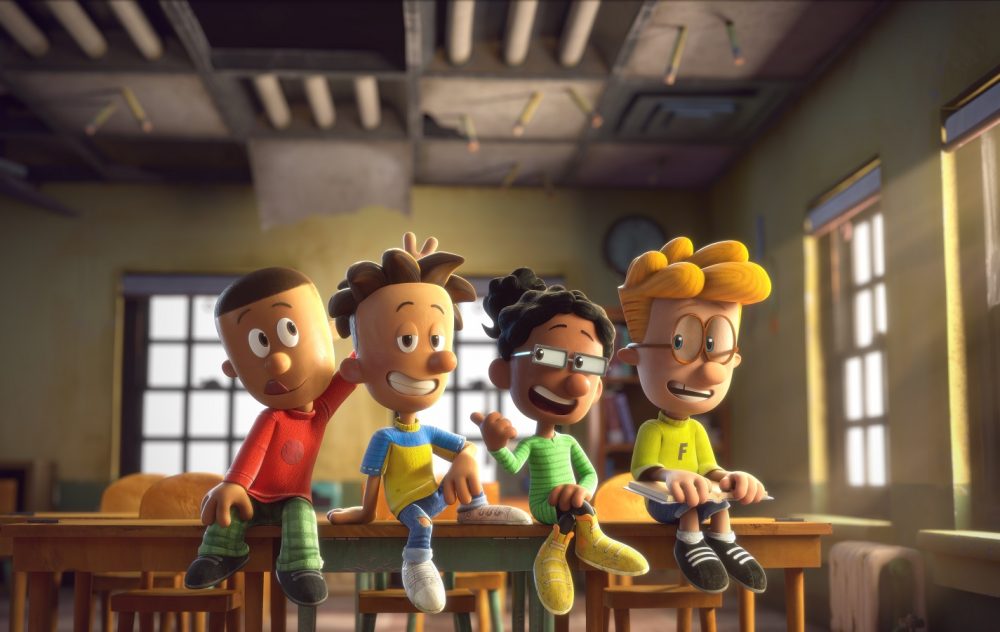
Dar: Ahead of the animated series, I decided to read some Big Nate comics for myself and quickly fell in love with it. The comics have an embarrassment of riches with so many great running gags like “the power of Chad” and characters such as Nate’s grandparents and uncle Ted who’s a bit of an emotionally stunted manchild but one of my favorite characters. Can we look forward to seeing some of those gags and characters I mentioned? If not, are you hoping to eventually bring in more characters from the comic if there is a potential second season?
Cohen: I will say that we are blessed to have this huge, huge universe. It’s kind of like what The Simpsons built up over as many seasons as they did. They just kept growing and expanding to this entire world and community of characters. We love those characters [that you mentioned] as well. I will tell you that they all do find their way into the series. It takes a little bit of time. You’ll see in this first batch that’s being released on February 17th just a taste of the world. But it will continue to grow.


